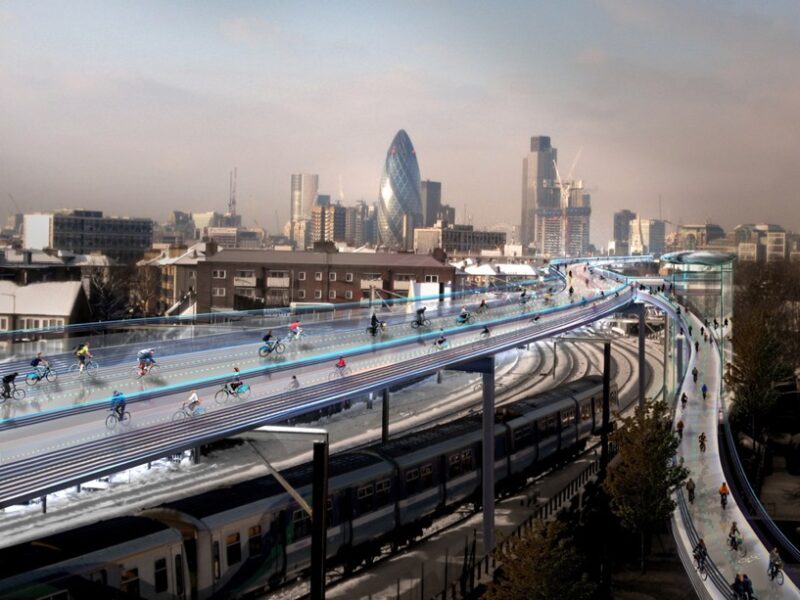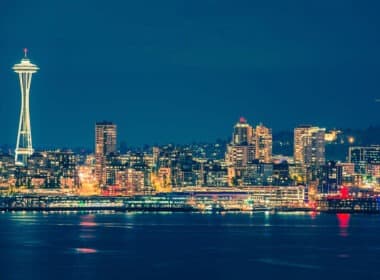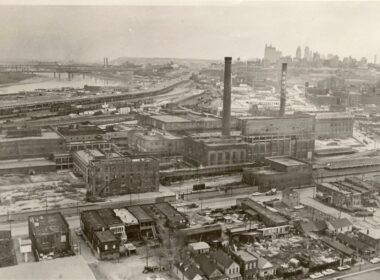Exterior Architecture, Foster + Partners and Space Syntax – a team who share Lord Foster’s passion for the benefits of cycling – have jointly developed SkyCycle, a new approach to transform cycling in the capital. Following existing suburban railway corridors, a wide, secure deck would be constructed above the trains to create new cycle routes throughout London.
The proposed SkyCycle network follows existing suburban rail services and provides over 220 kilometres of safe, car free cycle routes which can be accessed at over 200 entrance points. Almost six million people live within the catchment area of the proposed network, half of whom live and work within 10 minutes of an entrance. Each route can accommodate 12,000 cyclists per hour and will improve journey times by up to 29 minutes.

The Mayor’s aim is for London to be the best major city in the world. However, the capital’s transport network is at capacity and faces the challenge of population growth of 12 percent over the next decade. The government has committed to investment in transport, through airport planning, high-speed rail, Thameslink and Crossrail. The Mayor’s transport strategy also seeks to address the needs of pedestrians and cyclists in the city’s crowded streets and in areas where the public realm is poor. The environmental and health benefits of cycling notwithstanding, the bicycle is a more efficient use of London’s limited space – we believe there is a pressing need for network modelling of new capacity for these active, self-determined modes of transport.
The SkyCycle approach is revolutionary, and has potential applications in cities around the world. Applying lateral thinking, Britain’s engineering expertise and investment in transport technology could lead to the creation of an efficient platform building system.
As London’s railway lines were originally built for steam trains, they follow contours that naturally reduce the amount of energy expended and avoid steep gradients. SkyCycle exploits this historic legacy. Associated benefits include the regeneration of the typically low value, often underutilized industrial sites next to railway lines; vertically layering the city to create new social spaces and amenities on these cycling high streets; and the integration of automated goods delivery networks.
Early studies of a SkyCycle system indicate that it provides capacity at a much lower cost than building new roads and tunnels. The possibility of the deck providing development opportunities for businesses along the route, particularly where it intersects with stations and bridges, has also been the subject of the study, exploring ideas for public/private commercial growth and regeneration. The SkyCycle study team will continue to further develop these scenarios, and the project has already been presented to the GLA, TfL and Network Rail, as well as to developers and contractors with specialist rail experience.
Lord Foster:
“Cycling is one of my great passions – particularly with a group of friends. And I believe that cities where you can walk or cycle, rather than drive, are more congenial places in which to live. To improve the quality of life for all in London and to encourage a new generation of cyclists, we have to make it safe. However, the greatest barrier to segregating cars and cyclists is the physical constraint of London’s streets, where space is already at a premium. SkyCycle is a lateral approach to finding space in a congested city. By using the corridors above the suburban railways, we could create a world-class network of safe, car free cycle routes that are ideally located for commuters.”
Sam Martin & Oli Clark of Exterior Architecture Ltd:
“SkyCycle is an urban cycling solution for London. A cycling utopia, with no buses, no cars and no stress. We are incredibly excited at how together with Foster + Partners our idea has been developed and now more recently turned into a truly world changing scenario by Space Syntax for revolutionizing cycling in London and possibly the world.”
Anna Rose, Space Syntax:
“Space Syntax is delighted to be developing the SkyCycle concept with Exterior Architecture and Foster + Partners. At crucial points in London’s history major infrastructure projects have transformed the fortunes of the Capital: for example, Bazalgette’s sewer system helped remove the threat of cholera to keep London at the forefront of the industrial revolution; the Underground strengthened London’s core by making long-distance commuting possible. SkyCycle is conceived in this tradition as a network of strategic connections from the suburban edges to the centre, adding the much needed capacity for hundreds of millions of cycle journeys every year with all the social, economic, environmental and health benefits to London that follow. Space Syntax is evaluating these impacts, using a new generation of transport model to analyse cycle movement.”
A spokesman for Network Rail said:
“We welcome the proposals which have been put forward by Foster + Partners and Exterior Architecture and are always happy to look at ways we can contribute to improving travel and transport in London. We will continue to liaise with all involved as the aspiration for this innovative scheme develops.”
Cycling in London
Over the last decade, cycling has grown by 70 percent – on major roads the number of cyclists has increased by 173 percent. However, this still only translates as 2 percent of all journeys and falls short of many other UK and European cities. Road safety is a key factor: between 2006 and 2011, the number of cycling casualties rose by half. Cycling accounts for just 2 percent of daily journeys, but accounts for 20 percent of deaths and serious casualties on the roads. Political leadership in creating segregated cycle lanes, redesigning junctions and reducing the speed of traffic is the only way to make London a world-class cycling city. Analysis of the needs of commuters using bicycles shows that cyclists prefer to use direct routes.
However, space is severely restricted on the road network. The proposals examine how London could be turned into a safer, more compact city for cyclists by using the existing unused corridors above railway infrastructure. SkyCycle is a proposal to fully explore the potential of this underused asset to ease capacity constraints on London’s public transport systems and promote healthy, environmentally friendly transport choices.
Background on London
London’s population is expected to grow by 12 percent over the next decade, matching and then exceeding its previous high of 8.6 million in1939. In addition to housing challenges, with a lack of affordable homes and an increase in single households, this population growth, coupled with the demands of an ageing society, also places great pressure on public services and transport networks. The impact on systems that are already operating at capacity is further compounded by changing patterns of use – for example, people are working further away from their homes, as well as travelling around London more in their leisure time. The rapid rise in energy prices and transport policy decisions have not yet diminished the dominance of the motor vehicle on the capital’s roads, resulting in a poor public realm, with limited space for pedestrians, and contributing to an increase in air quality related diseases and obesity.
Foster + Partners
Lord Foster is a regular cyclist, who takes part in long-distance tours and is President of Britain’s National Byway Trust, a 3,300-mile network that promotes the health and environmental benefits of cycling by providing safe routes for all abilities across the country – this firsthand knowledge has led to a quest for safe cycling routes in London, where space is at a premium and sometimes bitterly contested. Like many companies in the capital, Foster + Partners has also seen an increase in cycling among staff – more than 200 people cycle to work and the practice has invested in dedicated facilities. Embracing the social benefits of cycling, the office even has its own cycling team.










